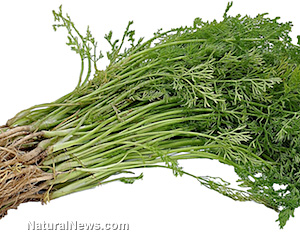Dr.
Harold Gunatillake, an affiliate of the Fellowship of the Royal
College of Surgeons, asserts that the herb, parsley, has more to offer
than being a mere colorful trimming on the delectable dishes most often
served in restaurants. Beyond its almost negligible size and its tasty
green dynamic flavor, parsley has plenty to offer in terms of health
benefits and disease prevention.
Most popular types of parsley
Two
very well-known types of parsley are the curly parsley and the Italian
flat leaf. The flat kind possesses a more aromatic scent and a less
pungent flavor compared to the curly type. The curly type is preferred
by people because of its decorative look that is great for use as
garnishing. Another type of this herb, known as root or turnip-rooted
parsley, is grown for its roots similar to a type of oyster plant or the
weedy, biennial plant known as burdock. Root parsley is typically used
in cooking within the regions of Central and Eastern Europe. It is
used as a nibble or vegetable addition for stews, stocks, soups,
sauces, and casserole dishes.
Nutrition rating system
According
to the food rating system, a typical serving of parsley contains
vitamin K or potassium, vitamin C or ascorbic acid, vitamin A, folate,
iron, and zero calories. A small stem of parsley has two uncommon
elements that provide exceptional heath benefits. One is a volatile
oil, specifically, myristicin, while the other component is made up of
flavonoids.
Prevention of illnesses and cell damage
In
the course of animal researches, volatile oils have been proven to
impede development of tumors specifically in the lung area. Myristicin
was also proven to trigger glutathione-S-transferase, an enzyme that
facilitates the attachment of the glutathione molecule to molecules that
have gone through the oxidation process. The actions of volatile oils
make these food components serve as neutralizers for certain types of
carcinogenic substances. Luteolin, one of the flavonoids, has been
proven to function as an antioxidant. It combines with very reactive
molecules that carry oxygen or oxygen radicals. This combination helps
in preventing cell damage. Parsley extracts were utilized in animal
researches and were proven to help in improving the blood's antioxidant
function.
Conclusion
In summary, apart from
these flavonoids and volatile oils, Dr. Gunatillake reports this herb
as one of the best sources of essential nutrients. It contains folic
acid, vitamin A or the anti-infective vitamin, and vitamin C which is
useful in preventing illnesses. It helps in lowering the levels of free
radicals and in maintaining the healthy function of the body's immune
system. Parsley may also facilitate good appetite, improve the
digestive process and urine production, diminish spasms, and increase
menstrual flow.

ليست هناك تعليقات:
إرسال تعليق